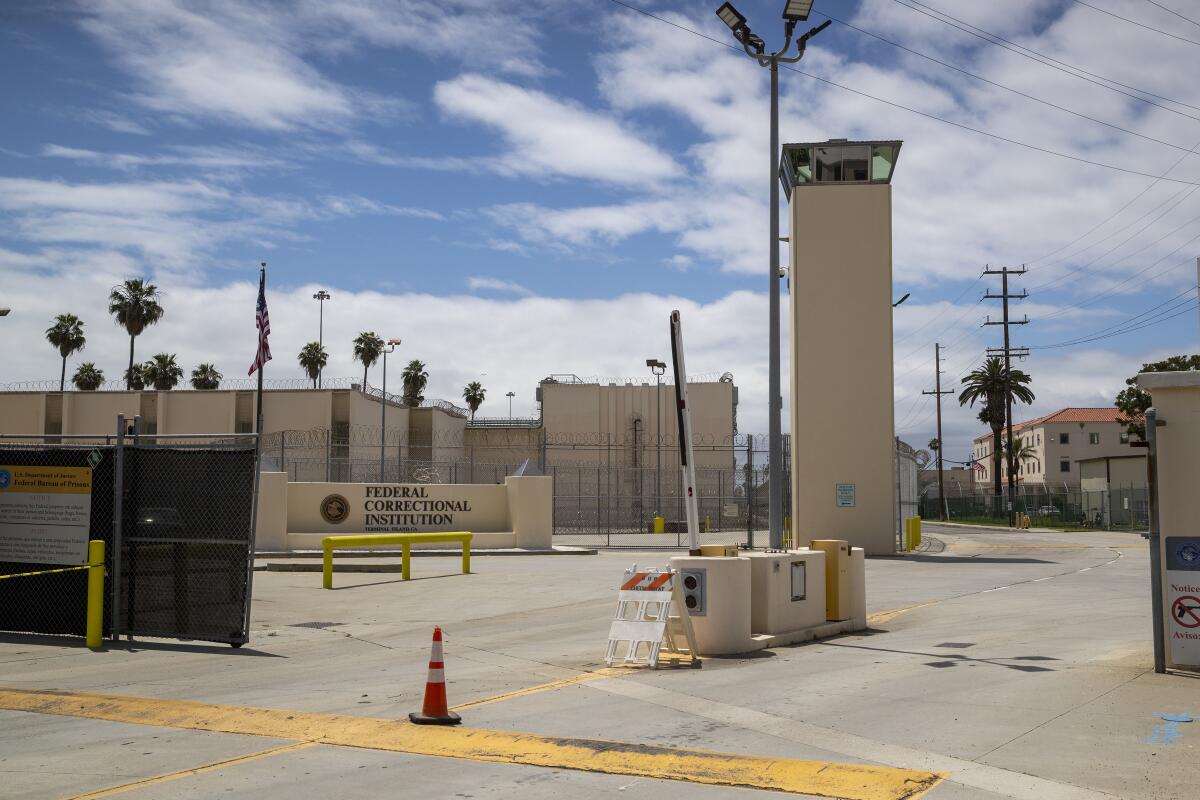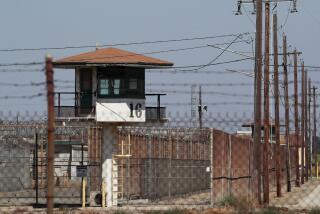Officials mishandled coronavirus outbreaks at Lompoc and Terminal Island prisons, lawsuits claim

The American Civil Liberties Union on Saturday filed a pair of class-action lawsuits on behalf of federal prisoners at Lompoc and Terminal Island, claiming officials mishandled coronavirus outbreaks at the facilities that have infected a combined total of 1,775 inmates, killing 10.
âWhile the rest of California took extraordinary measures to stop the spread of coronavirus, the Bureau of Prisons failed to take preventive measures as basic as isolating sick prisoners, allowing social distancing, or providing enough soap,â Peter Bibring, senior staff attorney at the ACLU of Southern California, said in a statement. âTheir deliberate indifference to the risk of disease violates the Constitution, and puts both those in prison and the surrounding community at risk.â
The lawsuits, which name the prisonsâ wardens, as well as Michael Carvajal, director of the federal Bureau of Prisons, claim that officials at both facilities allowed the virus to spread by failing to provide clean environments, basic sanitary supplies and personal protective equipment to prisoners and staff.
Overcrowding makes it impossible for prisoners to maintain social distancing or take other precautions, but officials have refused to consider the majority of inmates for release into home confinement despite directives that they do so, according to the lawsuits. The refusal amounts to cruel and unusual punishment prohibited by the 8th Amendment, the suits claim.
The Bureau of Prisons did not immediately return a message seeking comment Sunday.
The Terminal Island prison in San Pedro is a low-security facility that specializes in housing prisoners who need long-term medical or mental health care. As of Sunday, 692 inmates had tested positive for COVID-19 and eight had died, according to federal Bureau of Prisons figures. Fifteen staffers also had tested positive.
The prison houses 1,042 inmates despite a rated capacity of 779, according to the Terminal Island lawsuit.
In an attempt to provide more space, prison officials have moved inmates into field tents and warehouses that were hastily converted into makeshift living spaces, the lawsuit states. Still, they have failed to ensure social distancing or isolation of infected inmates within the structures, merely creating ânew hot zones for the virus to spread at an even more rapid rate,â the complaint states.
Two Terminal Island prisoners named in the lawsuit â Maurice Smith, 50, and Edgar Vasquez, 32 â say that, amid the outbreak, they were moved to one such space, an old warehouse that had no heating or hot water for showers. The warehouse is also âinfested by a veritable menagerie,â including mice, raccoons, feral cats, possums, skunks, and bats that fly through holes in the ceiling, the lawsuit states.
There, inmates sleep on folding cots three feet from the floor, and up to 60 prisoners share four toilets, four sinks and four showers, according to the lawsuit.
âIn the face of a COVID-19 outbreak, Terminal Island has the worst of all worlds,â the lawsuit states. âIt is overcrowded enough to make effective social distancing and isolation ... impossible, [and] open and communal enough for inmates to frequently interact in close quarters to spread the disease, while also hosting a uniquely vulnerable inmate population.â
Both complaints note that the CARES Act, which became law March 27, gave Bureau of Prisons officials broad discretion to reduce prison populations by releasing inmates into home confinement. That was followed by an April 3 memo issued by Atty. Gen. William Barr urging the bureau to take such actions for medically at-risk prisoners, especially at facilities with outbreaks, the lawsuits state.
At least two of the Terminal Island inmates who died from COVID-19 â Scott Cutting, 70, and James Lino, 65, both of whom had underlying health conditions â should have been on the shortlist to be released into home confinement per the directive, the lawsuit states.
Although the menâs estates are not named as plaintiffs, the lawsuit says it seeks to have other medically vulnerable inmates who live at the prison avoid their fates.
They include Lance Wilson, 35, who suffers from hypertension and asthma. Wilson tested positive for the coronavirus in early May and has been experiencing symptoms that include migraines and chills but has not been able to see a doctor, according to the lawsuit. He submitted an application to be considered for home confinement last month but received no reply, the complaint states.
At the Federal Correctional Institution Lompoc, a low-security prison in Santa Barbara County, 924 inmates and 17 staff had tested positive as of Sunday. In addition, 159 inmates and 22 staff members have become infected at the U.S. Penitentiary Lompoc, a neighboring medium-security prison on the same grounds, and two inmates there have died.
Combined, the two federal prisons in Lompoc have had 1,083 infected inmates, according to the Bureau of Prisons, making it the worst outbreak at any federal correctional facility by far.
The number of inmates with a positive test result is likely an undercount, the lawsuit claims, because only the 963 prisoners at FCI Lompoc have been mass tested, with nearly 96% testing positive. Officials have not tested all of the 1,700 inmates at the penitentiary, according to the lawsuit.
Yonnedil Torres, 24, an inmate at the penitentiary who suffers from chronic asthma, was ignored for five days after he developed symptoms that included a fever and body aches, the lawsuit states. He was only tested for the coronavirus and found to be positive after he collapsed in his cell due to acute respiratory shock, according to the complaint.
Torres was placed in a medically induced coma and put on a ventilator; the illness left him with severe lung damage, according to the lawsuit. Though his family submitted an application for compassionate release, they have not received a reply, the lawsuit states.
In addition to failing to reduce crowding and take precautions to slow the spread of the virus, officials have not provided inmates who have become infected with adequate medical care, the lawsuit claims.
Penitentiary inmate Vincent Reed, 53, who has hypertension, received no treatment when he developed symptoms and tested positive in late March, according to the lawsuit. Instead, he was placed in solitary confinement for days and then transferred to an old, unsanitary housing unit with other inmates who had tested positive, where he still received no medical care, the lawsuit states. On April 14, he was returned to the general population without being re-tested to ensure he was negative, according to the complaint.
After testing negative for the virus, inmate Felix Samuel Garcia, 36, was abruptly moved from the low-security prison in Lompoc to the penitentiary, according to the lawsuit. There, heâs being housed in a makeshift cell block set up in a warehouse, where he is not allowed to change into clean clothes or shower and must wet his body with sink water to stay clean, according to the lawsuit.
Garcia, who is set to be transferred to a halfway house in July, was told that staff were not accepting forms required to initiate the process of release into home confinement due to âthe exigency of the COVID-19 pandemic,â the lawsuit claims.
âCongress gave prisons broad authority to release low-risk offenders into home confinement so that it could reduce overcrowding and save lives,â said Naeun Rim, a principal with Bird Marella, which filed the suit along with the ACLU and the Prison Law Office. âBut officials failed to use that authority. We will hold them accountable in court.â
A goal of the lawsuits is to have inmates considered for release into home confinement, by order, through a highly expedited process.
In addition, they request that the prisons be immediately compelled to provide remaining inmates with adequate space for social distancing, individual supplies of hand soap and paper towels, and access to hand sanitizer, daily showers, clean laundry and other supplies.
âThe Constitution requires that prison officials provide a safe environment for people in their custody,â Donald Specter, executive director of the Prison Law Office, said in a statement. âNot only are these two prisons extremely dangerous, but they confine people who are especially vulnerable to COVID-19.â
More to Read
Sign up for Essential California
The most important California stories and recommendations in your inbox every morning.
You may occasionally receive promotional content from the Los Angeles Times.










